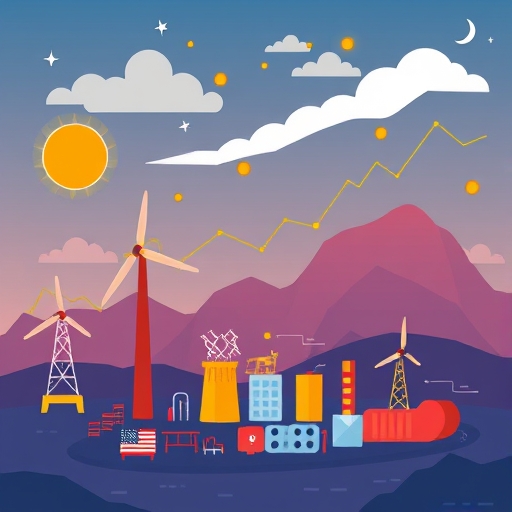Fueling Your Portfolio: Understanding and Investing in the Dynamic World of Energy ETFs
Have you ever wondered how to invest in the vast and ever-changing energy market without picking individual stocks? The global energy sector is a cornerstone of our economy, constantly influenced by everything from geopolitical events and supply-demand shifts to the accelerating push for sustainability. For many, navigating this complex landscape can feel overwhelming. This article will demystify Energy Exchange-Traded Funds (ETFs), explaining what they are, how they work, and the distinct opportunities and challenges they present. We’ll explore the various types of energy ETFs, highlight key metrics for evaluation, and provide a balanced view of the risks and rewards involved, guiding you toward a more strategic approach to energy investing.
The energy market, encompassing both traditional fossil fuels and burgeoning renewable sources, is vital for daily life and industrial activity. It’s a sector known for its significant volatility, driven by the interplay of economic supply and demand, alongside potent geopolitical influences. For individual investors, gaining exposure to such a dynamic sector can be difficult, often requiring deep industry knowledge and constant monitoring. This is where Energy ETFs come into play, offering a streamlined way to invest in a diversified basket of energy companies through a single, tradable asset.

What Are Energy ETFs and Why Consider Them?
An Exchange-Traded Fund (ETF) is an investment vehicle that holds a collection of assets, such as stocks, bonds, or commodities. Unlike mutual funds, ETFs trade on stock exchanges throughout the day, much like individual stocks, offering liquidity and flexibility. An Energy ETF specifically focuses on companies operating within the energy sector. This can include anything from giants involved in the exploration, production, refining, and distribution of oil and natural gas, to firms pioneering technologies in solar, wind, and hydropower.

The primary appeal of Energy ETFs lies in their ability to provide diversified exposure to the energy market. Instead of researching and buying shares in multiple energy companies, you can invest in a single ETF that holds a broad portfolio. This diversification helps mitigate the risk associated with any single company’s performance, as the ETF’s value is tied to the performance of many companies. For instance, if one oil company faces operational issues, the impact on a broadly diversified energy ETF might be lessened by the stronger performance of other holdings within the fund.
We often choose Energy ETFs for several fundamental reasons. First, they offer ease of access to a sector that might otherwise be difficult for individual investors to navigate. Second, they can provide exposure to essential global demand; as long as the world needs energy, companies in this sector will likely remain relevant. Third, some Energy ETFs can offer attractive dividend payouts, providing a potential source of income for investors. Lastly, they are transparent, with their holdings and prices updated frequently throughout the trading day, allowing you to react quickly to market conditions.
Beyond these core advantages, Energy ETFs also offer several practical benefits for the modern investor. These include:
- They typically have lower expense ratios compared to actively managed mutual funds, making them a cost-effective investment choice.
- ETFs often provide instant diversification, allowing investors to gain exposure to an entire sector or sub-sector with a single transaction, rather than buying individual stocks.
- Their transparency means investors can see the underlying holdings daily, providing clear insight into what they own.
The Dual Landscape: Traditional vs. Clean Energy ETFs
The energy sector is not monolithic; it’s broadly divided into two major camps: traditional fossil fuels and the rapidly growing clean or renewable energy segment. Understanding these distinctions is crucial for aligning your investments with your financial goals and personal values. Currently, fossil fuels (oil, gas, coal) still dominate global energy consumption, accounting for approximately 80% of the total. However, there’s an undeniable and accelerating global shift towards sustainable sources.
To further illustrate the current landscape, here’s a simplified breakdown of global primary energy consumption sources:
| Energy Source Category | Approximate Global Share (2022) | Key Characteristics |
|---|---|---|
| Fossil Fuels (Oil, Gas, Coal) | ~80% | High energy density, established infrastructure, significant CO2 emissions |
| Renewables (Solar, Wind, Hydro, Geothermal) | ~8% | Growing rapidly, lower emissions, variable output, increasing cost-efficiency |
| Nuclear Power | ~4% | Low-carbon, high output, waste disposal challenges |
| Bioenergy (Traditional & Modern) | ~8% | Renewable, but can have sustainability concerns depending on source |
Traditional Energy ETFs typically invest in companies focused on the exploration, extraction, processing, and transportation of oil, natural gas, and coal. These funds often hold shares in major integrated energy companies like Exxon Mobil Corp, Chevron Corp, Shell PLC, and TotalEnergies. They offer exposure to the established, large-cap players that underpin much of the world’s current energy infrastructure. Examples include the Energy Select Sector SPDR Fund (XLE), which tracks large-cap U.S. energy companies in the S&P 500, or the iShares Global Energy ETF (IXC), offering broader international exposure.
On the other hand, Clean Energy ETFs, also known as Renewable Energy ETFs, specifically target companies involved in producing energy from sustainable sources like solar, wind, and hydropower. These funds often exclude companies exceeding specific CO2 emission thresholds, catering to investors with an ethical or environmental focus, often called an “ESG” (Environmental, Social, and Governance) approach. Companies like First Solar Inc, Enphase Energy Inc, Vestas Wind Systems, and Iberdrola SA are common holdings. The iShares Global Clean Energy ETF (ICLN) and the Invesco Solar ETF (TAN) are prominent examples in this burgeoning category. While renewable energy sources represented a smaller share (around 8% in 2022), they are projected to grow significantly as global energy consumption is expected to increase by approximately 15% between 2021 and 2050.
Here is an overview of common sub-sectors within the energy market:
| Energy Type | Sub-sectors / Focus Areas | Representative Companies/Activities |
|---|---|---|
| Traditional Energy | Upstream (Exploration & Production) | Oil & gas drilling, well operations, resource discovery |
| Traditional Energy | Midstream (Transportation & Storage) | Pipelines, LNG terminals, storage facilities |
| Traditional Energy | Downstream (Refining & Marketing) | Refineries, gas stations, petrochemicals |
| Clean Energy | Solar Power | Photovoltaic (PV) panel manufacturing, solar project development |
| Clean Energy | Wind Power | Wind turbine manufacturing, wind farm operations |
| Clean Energy | Hydropower & Geothermal | Hydroelectric dam operations, geothermal energy extraction |
Your choice between these two types of Energy ETFs hinges on your investment philosophy. Are you seeking exposure to the stable, albeit sometimes controversial, demand for traditional energy, or are you looking to capitalize on the growth potential and environmental benefits of the clean energy transition? Both paths present unique opportunities and risks, which we will explore further.

Key Players and Understanding ETF Selection Metrics
When selecting an Energy ETF, it’s not enough to simply know its focus. We need to look at specific metrics and how the ETF is managed to make an informed decision. Major ETF issuers such as BlackRock (iShares), Vanguard, State Street Global Advisors (SPDR), Fidelity, and Invesco offer a wide range of options. These funds track various indices, such as the S&P 500 Energy Sector, MSCI World Energy, or the MAC Global Solar Energy Index, aiming to replicate their performance.

Here are some key metrics and concepts to consider when evaluating Energy ETFs:
- Assets Under Management (AUM): This figure represents the total value of assets held by the ETF. Generally, larger AUM indicates a more popular and liquid fund, which can be easier to trade.
- Expense Ratio (TER): This is the annual fee you pay as a percentage of your investment to cover the ETF’s operating costs. Lower expense ratios mean more of your money stays invested. Energy ETFs typically have expense ratios ranging from 0.08% to 0.85%, with an average around 0.67% for US-listed funds.
- Total Holdings: The number of different companies or assets the ETF holds. A higher number often implies greater diversification.
- Active Share: While most ETFs are passively managed (tracking an index), some employ an active strategy. Active share measures how much an ETF’s holdings differ from its benchmark index.
- Factor Exposures: Advanced investors often look at “factor-based investing,” where ETFs are ranked based on their exposure to certain investment styles, or “factors,” that have historically driven returns. These include:
- Value Exposure: Funds investing in undervalued companies.
- Momentum Exposure:
Funds investing in companies with recent strong performance. - Quality Exposure: Funds investing in companies with strong balance sheets and consistent earnings.
- Low Volatility Exposure: Funds designed to be less sensitive to market swings.
Multi-factor systems combine these to identify potentially more robust ETFs.
To illustrate, let’s consider a simplified comparison of a few prominent Energy ETFs:
| ETF Name (Ticker) | Focus | AUM (approx.) | Expense Ratio (approx.) | Key Holdings/Sector |
|---|---|---|---|---|
| Energy Select Sector SPDR Fund (XLE) | Traditional U.S. Energy (S&P 500) | $40B+ | 0.10% | Exxon Mobil, Chevron, ConocoPhillips |
| iShares Global Energy ETF (IXC) | Global Traditional Energy | $3B+ | 0.43% | Exxon Mobil, Chevron, Shell, TotalEnergies |
| Vanguard Energy ETF (VDE) | Broad U.S. Energy | $10B+ | 0.10% | Exxon Mobil, Chevron, Schlumberger |
| iShares Global Clean Energy ETF (ICLN) | Global Clean Energy | $5B+ | 0.46% | First Solar, Enphase Energy, Vestas Wind Systems |
| Invesco Solar ETF (TAN) | Global Solar Energy Specific | $2.5B+ | 0.69% | Enphase Energy, SolarEdge Technologies, First Solar |
(Note: AUM and Expense Ratios are approximate and subject to change.)
The Upside and Downside: Risks and Rewards of Energy ETF Investing
Like any investment, Energy ETFs come with their own set of potential benefits and inherent risks. A balanced understanding is crucial for any investor.
Potential Benefits (The Upside):
- Exposure to Essential Global Demand: The world’s need for energy is constant and growing. Investing in energy ETFs allows you to participate in this fundamental sector, which is critical for economic activity.
- Diversification: By holding a basket of companies, ETFs inherently offer diversification within the energy sector, reducing the impact of poor performance from a single stock. This can be a valuable addition to a broader investment portfolio.
- Liquidity and Transparency: As ETFs trade on exchanges like stocks, you can buy and sell them throughout the trading day at market prices, offering high liquidity. Their holdings are also typically disclosed daily, providing transparency.
- Income Potential: Many energy companies, particularly established traditional energy giants, pay dividends. As a result, many Energy ETFs pass these dividends on to investors, offering a potential income stream.
- Growth in Renewables: For Clean Energy ETFs, the potential for long-term growth is significant as the global transition to sustainable energy accelerates, driven by policy and technological advancements.
Inherent Risks (The Downside):
- High Volatility: The energy market is notoriously volatile. Prices for commodities like crude oil and natural gas can fluctuate wildly due to supply changes, geopolitical events, economic slowdowns, or even weather patterns. This directly impacts the profitability of energy companies and, consequently, the performance of Energy ETFs.
- Geopolitical Risks: Many major energy-producing regions are politically unstable. Conflicts, trade disputes, or changes in government policy can have immediate and significant effects on global energy supply and prices.
- Regulatory and Environmental Changes: Policies regarding CO2 emissions, carbon taxes, and national energy laws (especially in the U.S. and Europe) can significantly impact the performance of fossil fuel companies. Furthermore, environmental concerns, such as the “bad press” from incidents like oil spills, can damage company reputations and financial performance.
- Industry Phase-Out Risk (for Fossil Fuels): While fossil fuels still dominate, there’s a long-term prospect of a global phase-out or significant reduction in their use. This could lead to stranded assets and declining valuations for companies heavily invested in traditional energy.
- Concentration Risk: Even though ETFs offer diversification *within* the energy sector, investing solely in energy ETFs means your portfolio is concentrated in one sector, making it vulnerable to downturns affecting that specific industry.
- Model-Based Returns: Many investment analyses, especially for multi-factor systems, rely on model or back-tested returns. It’s crucial to remember that past performance does not guarantee future results, and these models often don’t account for real-world trading costs.
Understanding the interplay of these risks is vital for managing your energy investments. For example, geopolitical tensions often lead to immediate fluctuations in oil prices, impacting traditional energy ETFs, while shifts in government subsidies or technological breakthroughs can quickly affect clean energy ETFs.
Here’s a simplified view of how various factors can influence different types of Energy ETFs:
| Factor / Event | Impact on Traditional Energy ETFs | Impact on Clean Energy ETFs |
|---|---|---|
| Global Economic Boom | Increased demand for oil/gas, positive for prices and profits | Increased investment in new projects, higher demand for components |
| Geopolitical Conflict in Middle East | Supply disruptions, higher oil prices, potential volatility | Less direct impact, but could see increased interest as alternative |
| New Carbon Tax Legislation | Increased operating costs, potential negative impact on profits | Potential incentives, increased competitiveness against fossil fuels |
| Breakthrough in Battery Technology | Indirect negative impact (less demand for fossil fuels long-term) | Direct positive impact, increased efficiency and adoption of renewables |
| Global Recession | Decreased energy demand, lower prices, negative for profits | Reduced capital expenditure, slower project development, funding challenges |
As investors, we face a critical decision between traditional fossil fuel exposure and an ethically driven “green” portfolio. Both have their merits, and understanding these pros and cons will allow you to make choices aligned with your financial objectives and personal values.
Conclusion: Navigating Your Energy Investment Journey
Investing in Energy ETFs offers a compelling way to gain exposure to a sector that is fundamental to global economic activity. Whether you’re drawn to the established demand of traditional energy or the innovative growth potential of clean energy, a clear understanding of the underlying market dynamics, specific ETF characteristics, and associated risks is paramount. We’ve seen how ETFs provide diversification and accessibility, but also how they are subject to significant volatility, geopolitical influences, and evolving regulatory landscapes.
By carefully evaluating factors such as Assets Under Management, Expense Ratios, and the fund’s specific focus (traditional vs. clean energy), you can make more informed decisions. Remember that the energy transition is ongoing, presenting both challenges and opportunities across the sector. Your investment journey should always be guided by your personal financial goals and risk tolerance.
Disclaimer: This article is for informational and educational purposes only and should not be considered as financial advice. Investing in ETFs, particularly those focused on volatile sectors like energy, involves risks, including the potential loss of principal. Always consult with a qualified financial advisor before making any investment decisions.
Frequently Asked Questions (FAQ)
Q: What is the main difference between traditional and clean energy ETFs?
A: Traditional Energy ETFs focus on companies involved in fossil fuels (oil, gas, coal) across exploration, production, and refining. Clean Energy ETFs, on the other hand, invest in companies developing renewable sources like solar, wind, and hydropower. The choice often depends on an investor’s risk tolerance, market outlook, and ethical considerations regarding environmental impact.
Q: Are Energy ETFs suitable for all investors?
A: Energy ETFs can be a good option for investors seeking diversified exposure to the energy sector. However, due to the sector’s inherent volatility, sensitivity to geopolitical events, and regulatory risks, they are generally better suited for investors with a higher risk tolerance and a long-term investment horizon who can withstand potential price fluctuations.
Q: How do I choose between different Energy ETFs?
A: When selecting an Energy ETF, consider key metrics such as Assets Under Management (AUM) for liquidity, the Expense Ratio (TER) for costs, and the Total Holdings for diversification. Also, evaluate the ETF’s specific focus (e.g., U.S. traditional, global clean energy, solar-specific) and how it aligns with your personal investment goals and values. Reviewing the fund’s top holdings can also provide insight into its exposure.



No responses yet